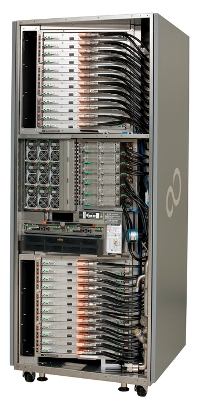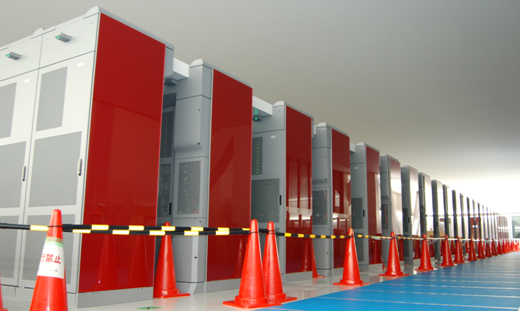Japan’s “K Computer“, which is being jointly developed by RIKEN (a large natural sciences research institute in Japan) and Fujitsu have taken the first place on the 37th TOP500 list of Super Computers announced at the 26th International Supercomputing Conference (ISC’11) held in Hamburg, Germany. The ranking of all systems is based on how fast they run Linpack, a benchmark application developed to solve a dense system of linear equations. Check out the complete top500 list.
There are only two supercomputers from India in the top500 list. The super computer Cluster Platform 3000 BL460c at Computational Research Laboratories, TATA SONS built by Hewlett-Packard is at the 58th position and the IBM built Power 575 super computer at the Indian Institute of Tropical Meteorology is at the 221th position.
 The TOP500-ranked K computer system, currently in the configuration stage, has 672 computer racks equipped with a current total of 68,544 CPUs. This half-build system achieved the world’s best LINPACK benchmark performance of 8.162 petaflops (quadrillion floating-point operations per second), to place it at the head of the TOP500 list. In addition, the system has recorded high standards with a computing efficiency ratio of 93.0%. This is the first time since June 2004 that the Japanese supercomputer “Earth Simulator” has been ranked first on the TOP500 list.
The TOP500-ranked K computer system, currently in the configuration stage, has 672 computer racks equipped with a current total of 68,544 CPUs. This half-build system achieved the world’s best LINPACK benchmark performance of 8.162 petaflops (quadrillion floating-point operations per second), to place it at the head of the TOP500 list. In addition, the system has recorded high standards with a computing efficiency ratio of 93.0%. This is the first time since June 2004 that the Japanese supercomputer “Earth Simulator” has been ranked first on the TOP500 list.
The K computer, which is being jointly developed by RIKEN and Fujitsu, is part of the High-Performance Computing Infrastructure (HPCI) initiative led by Japan’s Ministry of Education, Culture, Sports, Science and Technology. Configuration of the K computer began in the end of September 2010, with availability for shared use scheduled for 2012.
The “K computer” is the nickname RIKEN has been using for the supercomputer of this project since July 2010. “K” comes from the Japanese Kanji letter “Kei” which means ten peta or 10 to the 16th power. The logo for the K computer based on the Japanese letter for Kei, was selected in October 2010. In its original sense, “Kei” expresses a large gateway, and it is hoped that the system will be a new gateway to computational science.

RIKEN (Rikagaku Kenkyūjo) is founded in 1917 and employs approximately 3000 scientists on seven campuses across Japan. Fujitsu is a leading provider of information and communication technology (ICT)-based business solutions for the global marketplace. Fujitsu has approximately 170,000 employees supporting customers in over 100 countries.
LINPACK is a program developed by J. Dongarra, Ph.D., of the University of Tennessee, for solving a system of linear equations using matrix computation. It is the benchmark program used to create the TOP500 list, which ranks the performance of the world’s supercomputers, announced in June and November of every year.
RIKEN and Fujitsu have been working together to develop the K computer, with the aim of beginning shared use by November 2012, as a part of the High-Performance Computing Infrastructure (HPCI) initiative led by Japan’s Ministry of Education, Culture, Sports, Science and Technology (MEXT). The K computer will be comprised of over 800 computer racks—each equipped with ultrafast and energy-efficient CPUs—that access into a network capable of an immense amount of interconnectivity. The supercomputer system brings together leading-edge technologies for high performance and high reliability.
To test the system’s performance at the configuration stage, the K computer’s processing speed was measured by the LINPACK benchmark program, placing it on the 37th TOP500 ranking of the world’s fastest supercomputers. The TOP500 ranking list began in 1993 and is updated twice a year in June and November.
Performance and Future Status of the K computer
The LINPACK benchmark program, running on the part of the system that employs 68,544 CPUs installed on the K computer being configured, recorded the world’s top performance of 8.162 petaflops. This gave it the number-one position on the TOP500 list. Moreover, for one of the world’s largest supercomputers, it achieved an extraordinarily high computing efficiency ratio of 93.0%. This achievement is made possible by the K computer’s integration of technologies, including its massive number of CPUs, the interconnectivity that links them together, and the software that is able to bring out the highest performance from the hardware.
When configuration of the K computer is complete in 2012, it is designed to achieve LINPACK performance of 10 petaflops. It will be widely used in a variety of computational science fields where it is expected to contribute to the generation of world-class research results. The K computer is a wholly made-in-Japan supercomputer, from the research and development of the processors, to system design and manufacturing. Use of the K computer is expected to have a groundbreaking impact in fields ranging from global climate research, meteorology, disaster prevention, and medicine, thereby contributing to the creation of a prosperous and secure society. RIKEN and Fujitsu will continue to work tirelessly toward completing the system’s deployment in 2012. [source]


Be the first to comment